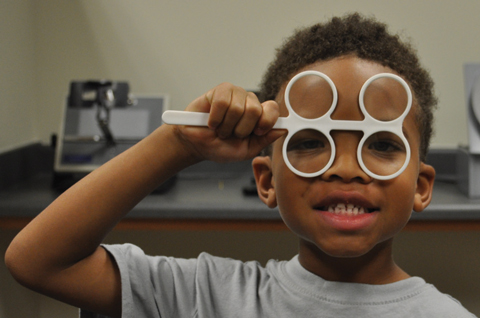 |
|
Inequities in amblyopia outcomes by socioeconomic status are related to delays in recognizing amblyopia. Persistent amblyopia was associated with non-English speaking families, lower estimated household income and living in a less-resourced neighborhood. Photo: Kara Tison, OD. Click image to enlarge. |
The optimal interventions to reduce discrepancies in amblyopia outcomes are currently unknown. They may relate to differences in age of diagnosis, treatment compliance, ability to access pediatric eye care or other factors. Registry and population-based studies have limited capacity to evaluate the role of these factors, due to their inability to access detailed clinical data. Researchers based out of the University of Southern California in Los Angeles conducted a retrospective study of children over a 10-year period to identify clinical and sociodemographic factors associated with disparities in amblyopia treatment outcomes. They determined that children who were older at diagnosis and whose families had governmental insurance, spoke Spanish as the primary language and had lower socioeconomic status were more likely to experience amblyopia persistence. Their findings were published in Ophthalmology last week.
Children with amblyopia were categorized by outcome: resolved amblyopia (<0.2 logMAR interocular difference in visual acuity, or no fixation preference in non-verbal patients) or persistent amblyopia. Overall, 168 patients met inclusion criteria, and 131 (78%) had resolved amblyopia. The most common reasons that the other patients did not meet study criteria included mild amblyopia (less than two lines of intraocular difference in visual acuity), current amblyopia treatment, age greater than eight at time of diagnosis and bilateral or deprivation amblyopia. Demographic and clinical data were recorded from the medical record. Zip codes were used to calculate Childhood Opportunity Index scores, estimated annual household income and distance to the hospital. The Child Opportunity Index is a composite score that grades neighborhoods across the United States by factors that support the healthy development of children. There are three domains within the score: education, health and environment, and social and economic.
As expected, younger age at diagnosis and lower interocular difference in visual acuity at presentation were associated with treatment success. However, a number of demographic and socioeconomic factors were also found to be related to amblyopia outcomes.
Demographic factors associated with resolution of amblyopia were younger age at diagnosis (3.3 vs. 4.5 years), English as the primary language (79.4% vs. 62.2%), higher estimated annual income ($83,316 vs. $71,623), higher Childhood Opportunity Index scores (50.9 vs. 40.0) and living further from the researchers’ children’s hospital (28.6 vs. 14.9 miles). Patients with resolved amblyopia also had higher rates of treatment compliance (83.2% vs. 75.6%) and shorter delays in follow-up (40.1 vs. 61.1 days).
Although ethnicity was not significantly associated with amblyopia resolution in this study, Spanish as the primary language was associated with persistent amblyopia.
Some patients with governmental insurance experienced delays in scheduling an ophthalmology consultation at the researchers’ hospital due to initial attempts to refer to other eye clinics that did not accept their insurance. Both governmental insurance and follow-up appointment delays were associated with amblyopia outcomes on univariate analysis in this study.
“On multivariate regression, the only factor independently associated with amblyopia outcome was age at diagnosis, suggesting that inequities in amblyopia outcomes by socioeconomic status are related to delays in recognizing amblyopia,” the study authors noted. “These findings suggest that improving access to early vision screening and comprehensive pediatric eye care is an important intervention to promote equity in amblyopia outcomes.”
| Click here for journal source. |
Matsunaga K, Rajagopalan A, Nallasamy S, et al. Disparities in amblyopia treatment outcomes: the impact of sociodemographic factors, treatment compliance and age of diagnosis. Ophthalmology. September 23, 2024. [Epub ahead of print]. |


